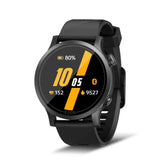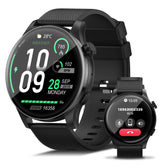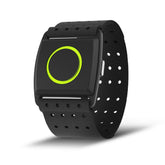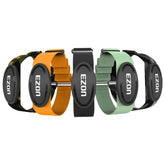The Future of Sports Wearables: ECG, Blood Oxygen Monitoring, and Stress Tracking
The Future of Sports Wearables: ECG, Blood Oxygen Monitoring, and Stress Tracking
The evolution of sports wearables has shifted from basic step counters to sophisticated health guardians. Today’s devices are no longer just fitness companions—they’re proactive health monitors equipped with ECG sports watch capabilities, blood oxygen monitor watch precision, and stress tracking watch insights. These medical-grade features are redefining how athletes and health-conscious users optimize performance, prevent injuries, and manage wellness. Let’s explore why these innovations are the cornerstone of next-gen wearables.
ECG Sports Watches: Heart Health at Your Wrist
Electrocardiogram (ECG) technology, once confined to hospitals, is now accessible through ECG sports watches. These devices detect irregular heart rhythms like atrial fibrillation (AFib) by measuring electrical signals across the chest. Brands like Apple Watch Series 9 and Withings ScanWatch have received FDA clearance for their ECG functionality, offering clinical-grade accuracy in seconds.
For athletes, this isn’t just about tracking heart rate zones. Sudden spikes in heart rate variability (HRV) or unexplained arrhythmias during training can signal overtraining, dehydration, or underlying cardiac issues. A ECG sports watch acts as an early-warning system, empowering users to adjust workouts or consult a doctor before minor issues escalate.
Blood Oxygen Monitor Watches: Beyond Altitude Training
Blood oxygen saturation (SpO2) tracking has moved from niche mountaineering gear to mainstream wearables. A blood oxygen monitor watch uses infrared sensors to measure how efficiently your body absorbs oxygen—a metric critical for endurance athletes, high-altitude hikers, and sleep apnea patients.
During sleep, consistently low SpO2 levels (below 90%) can indicate sleep disorders, while daytime dips may reflect respiratory infections or overexertion. Garmin’s Venu 3 and Fitbit Sense 2 leverage this data to provide recovery recommendations, like adjusting workout intensity or prioritizing rest days. For climbers, real-time SpO2 readings help prevent altitude sickness by signaling when to descend.
Stress Tracking Watches: Quantifying Mental Load
Chronic stress impairs physical performance and immune function. Modern stress tracking watches combat this by analyzing heart rate variability (HRV), skin temperature, and even vocal tone (via voice stress analysis in devices like Huawei Watch GT 4). These metrics feed into stress scores, prompting users to practice breathing exercises or take mindfulness breaks.
What sets advanced models apart is contextual awareness. For example, the Garmin Epix Pro correlates stress spikes with activity logs, weather changes, or calendar events. If your stress score remains elevated post-workout, it might suggest overtraining or inadequate recovery. Over time, these insights help users identify stress triggers and build resilience.
Synergy in Action: How These Features Work Together
The true power of ECG sports watches, blood oxygen monitor watches, and stress tracking watches lies in their integration. Consider these scenarios:
-
A runner’s ECG detects irregular heartbeats during a marathon, while SpO2 data reveals oxygen drops linked to poor pacing.
-
A hiker’s stress tracker flags elevated cortisol levels at high altitudes, prompting them to check SpO2 and descend before hypoxia sets in.
-
Sleep data from a blood oxygen monitor combines with nighttime ECG readings to uncover undiagnosed sleep apnea, validated by a physician.
This holistic approach transforms wearables into 24/7 health hubs, bridging the gap between fitness and preventive care.
Choosing the Right Device: Key Considerations
When shopping for medical-grade wearables, prioritize:
-
Certifications: Look for FDA-cleared ECG or CE-marked SpO2 sensors.
-
Battery Life: Opt for 7+ days to ensure continuous monitoring.
-
Data Privacy: Ensure HIPAA-compliant apps if sharing data with doctors.
-
Integration: Compatibility with EHR systems like Apple Health Records.
Top 2025 contenders include the Apple Watch Ultra 2 (ECG and temperature tracking), Garmin Venu 3 Plus (advanced sleep coaching with SpO2), and Whoop 5.0 (strain/recovery balance via HRV stress analysis).
The Road Ahead: AI and Predictive Health
Emerging trends are pushing boundaries further:
-
AI-Driven Alerts: Watches like the Samsung Galaxy Watch 7 use machine learning to predict AFib episodes hours before they occur.
-
Non-Invasive Glucose Monitoring: Prototypes from Abbott and Apple aim to pair SpO2 with blood sugar trends for diabetics.
-
Mental Health Focus: Devices may soon track cortisol levels via sweat sensors, offering real-time stress reduction prompts.
Final Thoughts
The era of ECG sports watches, blood oxygen monitor watches, and stress tracking watches isn’t just about data—it’s about actionable insights that save lives. By democratizing access to medical-grade tech, these wearables empower users to take control of their health, one heartbeat (or breath) at a time. As sensor accuracy improves and regulatory frameworks adapt, expect your wrist to become the most trusted tool in your healthcare arsenal.









